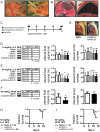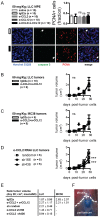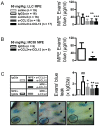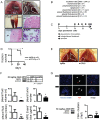Beneficial impact of CCL2 and CCL12 neutralization on experimental malignant pleural effusion
- PMID: 23967166
- PMCID: PMC3743892
- DOI: 10.1371/journal.pone.0071207
Beneficial impact of CCL2 and CCL12 neutralization on experimental malignant pleural effusion
Abstract
Using genetic interventions, we previously determined that C-C motif chemokine ligand 2 (CCL2) promotes malignant pleural effusion (MPE) formation in mice. Here we conducted preclinical studies aimed at assessing the specific therapeutic potential of antibody-mediated CCL2 blockade against MPE. For this, murine MPEs or skin tumors were generated in C57BL/6 mice by intrapleural or subcutaneous delivery of lung (LLC) or colon (MC38) adenocarcinoma cells. Human lung adenocarcinoma cells (A549) were used to induce MPEs in severe combined immunodeficient mice. Intraperitoneal antibodies neutralizing mouse CCL2 and/or CCL12, a murine CCL2 ortholog, were administered at 10 or 50 mg/kg every three days. We found that high doses of CCL2/12 neutralizing antibody treatment (50 mg/kg) were required to limit MPE formation by LLC cells. CCL2 and CCL12 blockade were equally potent inhibitors of MPE development by LLC cells. Combined CCL2 and CCL12 neutralization was also effective against MC38-induced MPE and prolonged the survival of mice in both syngeneic models. Mouse-specific CCL2-blockade limited A549-caused xenogeneic MPE, indicating that host-derived CCL2 also contributes to MPE precipitation in mice. The impact of CCL2/12 antagonism was associated with inhibition of immune and vascular MPE-related phenomena, such as inflammation, new blood vessel assembly and plasma extravasation into the pleural space. We conclude that CCL2 and CCL12 blockade are effective against experimental MPE induced by murine and human adenocarcinoma in mice. These results suggest that CCL2-targeted therapies may hold promise for future use against human MPE.
Conflict of interest statement
Figures






Similar articles
-
Host-derived interleukin-5 promotes adenocarcinoma-induced malignant pleural effusion.Am J Respir Crit Care Med. 2010 Nov 15;182(10):1273-81. doi: 10.1164/rccm.201001-0001OC. Epub 2010 Jul 1. Am J Respir Crit Care Med. 2010. PMID: 20595227 Free PMC article.
-
Tumor necrosis factor-alpha promotes malignant pleural effusion.Cancer Res. 2007 Oct 15;67(20):9825-34. doi: 10.1158/0008-5472.CAN-07-1064. Cancer Res. 2007. PMID: 17942913
-
Mast cells mediate malignant pleural effusion formation.J Clin Invest. 2015 Jun;125(6):2317-34. doi: 10.1172/JCI79840. Epub 2015 Apr 27. J Clin Invest. 2015. PMID: 25915587 Free PMC article.
-
Malignant pleural effusion: tumor-host interactions unleashed.Am J Respir Crit Care Med. 2012 Sep 15;186(6):487-92. doi: 10.1164/rccm.201203-0465PP. Epub 2012 May 31. Am J Respir Crit Care Med. 2012. PMID: 22652027 Free PMC article. Review.
-
Animal models of malignant pleural effusion.Curr Opin Pulm Med. 2009 Jul;15(4):343-52. doi: 10.1097/MCP.0b013e32832af07c. Curr Opin Pulm Med. 2009. PMID: 19387350 Review.
Cited by
-
The role of angiogenesis in malignant pleural effusion: from basic research to clinical application.Am J Cancer Res. 2022 Nov 15;12(11):4879-4891. eCollection 2022. Am J Cancer Res. 2022. PMID: 36504886 Free PMC article. Review.
-
RANK-c attenuates aggressive properties of ER-negative breast cancer by inhibiting NF-κB activation and EGFR signaling.Oncogene. 2018 Sep;37(37):5101-5114. doi: 10.1038/s41388-018-0324-y. Epub 2018 May 29. Oncogene. 2018. PMID: 29844572
-
Host Wnt5a Potentiates Microenvironmental Regulation of Ovarian Cancer Metastasis.Cancer Res. 2020 Mar 1;80(5):1156-1170. doi: 10.1158/0008-5472.CAN-19-1601. Epub 2020 Jan 13. Cancer Res. 2020. PMID: 31932454 Free PMC article.
-
Tumor-derived osteopontin isoforms cooperate with TRP53 and CCL2 to promote lung metastasis.Oncoimmunology. 2016 Nov 18;6(1):e1256528. doi: 10.1080/2162402X.2016.1256528. eCollection 2017. Oncoimmunology. 2016. PMID: 28197374 Free PMC article.
-
NRAS destines tumor cells to the lungs.EMBO Mol Med. 2017 May;9(5):672-686. doi: 10.15252/emmm.201606978. EMBO Mol Med. 2017. PMID: 28341702 Free PMC article.
References
-
- Maskell NA (2012) Treatment options for malignant pleural effusions: patient preference does matter. JAMA 307: 2432–2433. - PubMed
-
- Wu SG, Yu CJ, Tsai MF, Liao WY, Yang CH, et al... (2012) Survival of lung adenocarcinoma patients with malignant pleural effusion. Eur Respir J, In press. - PubMed
-
- Burgers JA, Kunst PW, Koolen MG, Willems LN, Burgers JS, et al. (2008) Pleural drainage and pleurodesis: implementation of guidelines in four hospitals. Eur Respir J 32: 1321–1327. - PubMed
-
- Davies HE, Mishra EK, Kahan BC, Wrightson JM, Stanton AE, et al. (2012) Effect of an indwelling pleural catheter vs chest tube and talc pleurodesis for relieving dyspnea in patients with malignant pleural effusion: the TIME2 randomized controlled trial. JAMA 307: 2383–2389. - PubMed
Publication types
MeSH terms
Substances
LinkOut - more resources
Full Text Sources
Other Literature Sources

